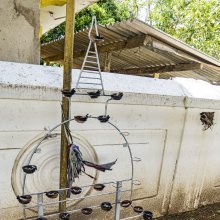Apala, Āpalā, Apālā, Apāla: 11 definitions
Introduction:
Apala means something in Hinduism, Sanskrit, Marathi. If you want to know the exact meaning, history, etymology or English translation of this term then check out the descriptions on this page. Add your comment or reference to a book if you want to contribute to this summary article.
Images (photo gallery)
In Hinduism
Purana and Itihasa (epic history)
Source: archive.org: Puranic EncyclopediaApālā (अपाला).—A daughter of the great sage, Atri. Suffering from leprosy and hence forsaken by her husband Apālā stayed with her father and started tapas to please Indra. One day, on her way home from the river, Apālā tasted the Soma which was meant to be offered to Indra and hearing the sound produced then Devendra appeared before Apālā. She gave the Soma to Indra, who was so pleased with her that he cured her of her leprosy. (Ṛgveda, 8-91).

The Purana (पुराण, purāṇas) refers to Sanskrit literature preserving ancient India’s vast cultural history, including historical legends, religious ceremonies, various arts and sciences. The eighteen mahapuranas total over 400,000 shlokas (metrical couplets) and date to at least several centuries BCE.
Ayurveda (science of life)
Dietetics and Culinary Art (such as household cooking)
Source: Shodhganga: Dietetics and culinary art in ancient and medieval IndiaApāla (अपाल) refers to a type of “rice-flour cake” derived from Atirasa, as described in the 17th century Bhojanakutūhala (dravyaguṇāguṇa-kathana), and is commonly found in literature dealing with the topics of dietetics and culinary art, also known as Pākaśāstra or Pākakalā.—(Atirasa ingredients): rice-flour, jaggery syrup and ghee. (Cooking instructions): Cook the rice flour in the syrup of jaggery. Knead the mixture and cook it in ghee. This preparation, resembling the colour of moon is known as atirasa. Here the author says that kneading process should be done particularly by the hands of a woman. It may seems to the softness of the dish by the hands of a lady. The same preparation containing more liquid content is called apāla.

Āyurveda (आयुर्वेद, ayurveda) is a branch of Indian science dealing with medicine, herbalism, taxology, anatomy, surgery, alchemy and related topics. Traditional practice of Āyurveda in ancient India dates back to at least the first millenium BC. Literature is commonly written in Sanskrit using various poetic metres.
Languages of India and abroad
Marathi-English dictionary
Source: DDSA: The Molesworth Marathi and English Dictionaryāpalā (आपला).—pron poss (āpaṇa) One's own, own. It answers to the pron pers āpaṇa throughout the persons of both numbers. See āpaṇa and its examples. 2 It often occurs expletively, as a mere pillow-word () for the listless or uncertain speaker. Ex. mī ā0 ēthūna uṭhalōṃ tōṃ ā0 tyācyā gharīṃ gēlōṃ. NOTE. āpalā is very commonly used, even by the educated, for āpaṇa, as āpa- lyāsa or āpalyālā for āpaṇāsa. This barbarism is to be discountenanced. āpalī vāḍhavūna khāṇēṃ To push forward selfishly one's own interests. āpalīśī karaṇēṃ To establish, set up, make to prevail one's own (will, cause, side); to carry one's own point. 2 To act like one's self; to keep in character. āpalāsā mhaṇaṇēṃ-samajaṇēṃ To call or suppose one's own or friendly-disposed towards one's self. Ex. piñjaṛyāntalā vāgha āpalāsā mhaṇūṃ nayē. āpalyā cēpayā dusaṛyā phulyā (Pressing down in the measure when helping himself; filling the measure loosely when helping others.) Used of a greedy or selfish person. tūṃ āpalā aisa Go to; mind your own business.
Source: DDSA: The Aryabhusan school dictionary, Marathi-Englishāpalā (आपला).—pro One's own. It corresponds to āpaṇa throughout its various mean- ings. It is often used as a pillow- word for the careless speaker as, mī āpalā yēthūna nighālōṃ. āpalī vāḍhavūna khāṇēṃ To selfishly advance one's own inter- ests. āpalīśī karaṇēṃ To establish one's own (will, side); to carry one's own point. To act like one's self. āpalāsā mhaṇaṇēṃ-samajaṇēṃ To call or suppose one's own or well-disposed to one's self. āpalyā cēpayā dusaṛyā phulyā Pressing down in the measure when helping himself filling the measure loosely when helping others. Used of a greedy person. āpalā tō bābyā dusaṛyācēṃ tēṃ kāraṭēṃ All his geese are swans. āpalā hāta āṇi jagannātha Liberty to appropriate to one's own satisfaction. āpalī pāṭha āpaṇāsa disata nāhīṃ One is not alive to one's own faults. He is not aware of the good or evil spoken of him behind his back. āpalēca dānta āṇi āpalēca ōṇṭha Used when one who inflicts punish- ment and one who receives it are closely connected. āpalēṃ nāka kāpūna dusa- ṛyālā apaśakūna Cut off your nose to spite your face. To injure oneself in or- der to injure others. āpalyā kānī sāta vāḷyā To profess total ignorance of. āpalyā pōḷīvara tūpa ōḍhaṇēṃ To usurp all be- nefit. tūṃ āpalā aisa Go to; mind your own business.
Marathi is an Indo-European language having over 70 million native speakers people in (predominantly) Maharashtra India. Marathi, like many other Indo-Aryan languages, evolved from early forms of Prakrit, which itself is a subset of Sanskrit, one of the most ancient languages of the world.
Sanskrit dictionary
Source: DDSA: The practical Sanskrit-English dictionaryApala (अपल).—a. Without flesh (palaśūnya).
-lam A pin or bolt.
Source: Cologne Digital Sanskrit Dictionaries: Shabda-Sagara Sanskrit-English DictionaryApala (अपल).—n.
(-laṃ) A pin or bolt. E. apa below, and lā to take, ḍa aff.
Source: Cologne Digital Sanskrit Dictionaries: Monier-Williams Sanskrit-English Dictionary1) Apala (अपल):—1. apala n. a pin or bolt, [cf. Lexicographers, esp. such as amarasiṃha, halāyudha, hemacandra, etc.]
2) [=a-pala] 2. a-pala mfn. fleshless.
3) Apāla (अपाल):—[=a-pāla] mf(ā)n. unguarded, unprotected, undefended
4) Apālā (अपाला):—[=a-pālā] [from a-pāla] f. Name of a daughter of Atri, [Ṛg-veda viii, 91, 7, etc.]
5) Āpala (आपल):—n. Name of a Sāman (cf. āpāla).
6) Āpāla (आपाल):—n. Name of a Sāman (cf. āpala).
Source: Cologne Digital Sanskrit Dictionaries: Goldstücker Sanskrit-English DictionaryApala (अपल):—I. n.
(-lam) A pin or bolt. E. ? Ii. [bahuvrihi compound] m. f. n.
(-laḥ-lā-lam) Without flesh &c. E. a priv. and pala.
--- OR ---
Apāla (अपाल):—[bahuvrihi compound] 1. m. f. n.
(-laḥ-lā-lam) Unprotected; e. g. kā tvamekākinī bhīru niranvayajane vane . kṣudhyantopyaghasanvyālāstvāmapālāṃ kathaṃ na vā. 2. f.
(-lā) A proper name: a daughter of Atri and authoress of a hymn of the Ṛgveda. E. a priv. and pāla.
Source: Cologne Digital Sanskrit Dictionaries: Yates Sanskrit-English DictionaryApala (अपल):—[a-pala] (laṃ) 1. n. A pin or bolt.
[Sanskrit to German]
Sanskrit, also spelled संस्कृतम् (saṃskṛtam), is an ancient language of India commonly seen as the grandmother of the Indo-European language family (even English!). Closely allied with Prakrit and Pali, Sanskrit is more exhaustive in both grammar and terms and has the most extensive collection of literature in the world, greatly surpassing its sister-languages Greek and Latin.
See also (Relevant definitions)
Partial matches: Paala, A, Pala.
Starts with (+31): A-palakopalam, Apala odo, Apalabddha, Apalada, Apalagna, Apalai, Apalak, Apalaka, Apalaki, Apalakopam, Apalakshana, Apalakshmana, Apalala, Apalaladamana, Apalalesi, Apalaleti, Apalam, Apalamba, Apalan, Apalana.
Ends with (+433): Aalapala, Abhayapala, Acapala, Achapala, Agnishomiyaikadashakapala, Aiyapala, Ajapala, Ajayapala, Alapala, Amirtapala, Amrapala, Amruthapala, Anagarika Dharmapala, Ananatapala, Anangapala, Anantapala, Andakapala, Ankapala, Antapala, Apa Apala.
Full-text (+76): Vipala, Apalam, Shatamana, Kuruvista, Caturthika, Kanakapala, Theka, Aba, Apala odo, Apalakopam, Lajima, Apapala, Apula, Apa Apala, Avalakshana, Apalapotariya, Kaphala, Apadhaka, Svanaman, Kamasala.
Relevant text
Search found 30 books and stories containing Apala, Āpalā, Apālā, Apāla, A-pala, A-pāla, A-pālā, Āpala, Āpāla; (plurals include: Apalas, Āpalās, Apālās, Apālas, palas, pālas, pālās, Āpalas, Āpālas). You can also click to the full overview containing English textual excerpts. Below are direct links for the most relevant articles:
Rig Veda (translation and commentary) (by H. H. Wilson)
Charaka Samhita and Sushruta Samhita (by Nayana Sharma)
Indra receives the knowledge of Āyurveda < [Chapter 8]
Sankhayana-grihya-sutra (by Hermann Oldenberg)
Contribution of Women to Sanskrit Literature < [April – June, 1985]
Some Thoughts on the Veda and its Study < [January – March, 1978]
The Agni Purana (by N. Gangadharan)
Chapter 286 - Collection of medical recipes (kalpa-sāgara)
Chapter 141 - Description of herbs used in charms, medicines etc.
Chapter 366 - Words relating to Kṣatriyas, Vaiśyas and other classes
Brihat Samhita (by N. Chidambaram Iyer)

